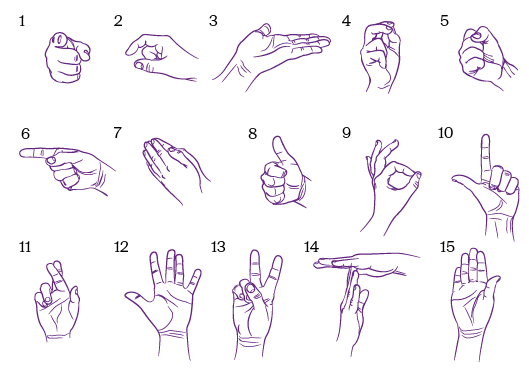209 Gestures
Gestures are a great way to not only make a presentation more lively, but to connect with an audience. But be cautious, gestures are also context and culture-specific. As best, we use them with a purpose and with an awareness of that context to emphasize specific points in our presentations.
Many nervous presenters fail to take advantage of gestures. If this is the case, begin by identifying areas in a presentation where you can specifically incorporate gestures and then rehearse the movement in front of a mirror or with a friend. Using slow, confident and practiced movements is already an improvement on no gestures, and as you get more comfortable, so to will the spontaneity of your gestures.
Also consider how you’ll vary your gestures, but still keep them relevant to your presentation. Too many gestures, especially when they don’t complement the material can be distracting — avoid jazz hands, excessive & repetitive movements that are just for show.
209.1 Meanings of Gestures
There are two broad meanings of gestures:
- Literal
- Communicate words, numbers, or position and are typically intuitive
- Figurative
- Communicate ideas or concepts and are context-dependent
Literal gestures include counting on your fingers, or pointing to show a position. In these cases the interpretation is not dependent on the context. Figurative gestures include spreading your hands apart to describe length, or swaying hands to show a flow of movement, or tracing showing the outline of a shape. Without context, an observer wouldn’t know what length, movement or object your trying to describe. A gesture may have both a literal or figurative meaning depending on the context in which it’s used. For example A thumbs-up usually signals agreement, but it can also signal increase if the situation calls for it. Without context, holding your hand up and showing your palm usually signals stop, but it can have any number of other interpretations depending on the situaiton.
209.2 Static versus Dynamic Gestures
Aside from the meaning inheret in gestures, we can also contrast static and dynamic gestures.
- Static Gestures
- A single gesture briefly displayed
- Dynamic Gestures
- A multi-step gesture of repetitive movements
It’s not to say that a dynamic gesture is “better” than a static, but that a particular situation may call for a more elaborate gesture.
209.3 3 Stages of Gestures
If you’re nervous about using gestures, consider these 3 stages in using gestures:
209.3.1 Stage 1 — No gestures at all
This is typical of many nervous and inexperienced presenters. For these presenters, the worst-case scenario is finding themselves hiding behind a podium. Althogh this adds comfort, it’s a literal barrier between them and the audience and should be avoided! Another tactic this crowd likes to make use of is hiding their hands in the pockets. This can come across as casual and easy for a confident presenter, but for the nervous crown it’s a terrible comfort that prevents them from using their hands to interact with the audience. There are also
209.3.2 Stage 2 — Undirected gestures
This is better than not gesturing at all, since at least your hands are moving. There is something to engage the audiences attention, but there is the real risk of moving too erratically and thus distracting the audience.
209.3.3 Stae 3 — Directed gestures
This is the goal in effective gesture use. Here, hand gestures are smooth and serve a purpose. There may still be erratic or undirected gesticulation, but most gestures complement what the speaker is saying.
209.4 Exercises
209.4.1 Interpreting Gestures
The figure below depicts 15 hand gestures. For each gesture, complete the table as follows:
- Impression — What kind of impression do you get from each gesture give. For example, does it express *8dominance/power, is it informal/friendly, is it describing something, is it instructing** us to look somewhere?
- Meanings — Describe literal or figurative meanings of each gesture. A gesture may have either or both. In some cases a gesture may have no meaning, but at best they are used purpsfully.

| Image | Impression | Literal Meaning | Figurative Meaning |
|---|---|---|---|
| 1 | |||
| 2 | |||
| 3 | |||
| 4 | |||
| 5 | |||
| 6 | |||
| 7 | |||
| 8 | |||
| 9 | |||
| 10 | |||
| 11 | |||
| 12 | |||
| 13 | |||
| 14 | |||
| 15 |
209.4.2 Self-improvements
Consider the gestures you’ve seen in different presentation situations. Where can you begin to integrate gestures into your own talk?